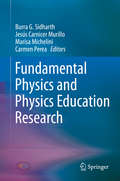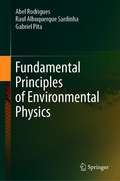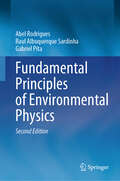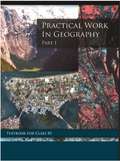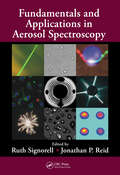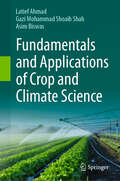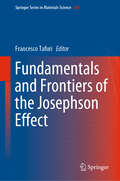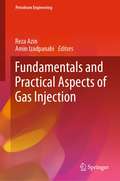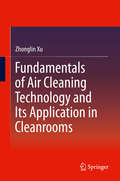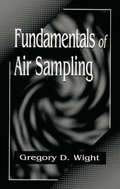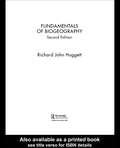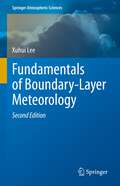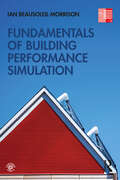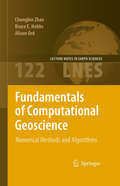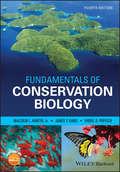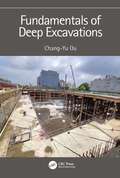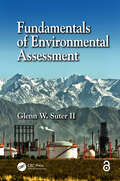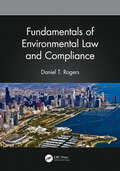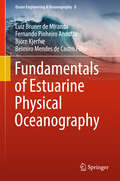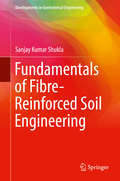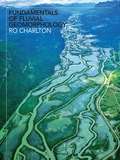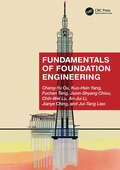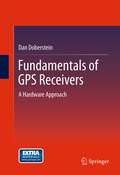- Table View
- List View
Fundamental Mathematical Structures of Quantum Theory: Spectral Theory, Foundational Issues, Symmetries, Algebraic Formulation
by Valter MorettiThis textbook presents in a concise and self-contained way the advanced fundamental mathematical structures in quantum theory. It is based on lectures prepared for a 6 months course for MSc students. The reader is introduced to the beautiful interconnection between logic, lattice theory, general probability theory, and general spectral theory including the basic theory of von Neumann algebras and of the algebraic formulation, naturally arising in the study of the mathematical machinery of quantum theories. Some general results concerning hidden-variable interpretations of QM such as Gleason's and the Kochen-Specker theorems and the related notions of realism and non-contextuality are carefully discussed. This is done also in relation with the famous Bell (BCHSH) inequality concerning local causality.Written in a didactic style, this book includes many examples and solved exercises.The work is organized as follows. Chapter 1 reviews some elementary facts and properties of quantum systems. Chapter 2 and 3 present the main results of spectral analysis in complex Hilbert spaces. Chapter 4 introduces the point of view of the orthomodular lattices' theory. Quantum theory form this perspective turns out to the probability measure theory on the non-Boolean lattice of elementary observables and Gleason's theorem characterizes all these measures. Chapter 5 deals with some philosophical and interpretative aspects of quantum theory like hidden-variable formulations of QM. The Kochen-Specker theorem and its implications are analyzed also in relation BCHSH inequality, entanglement, realism, locality, and non-contextuality. Chapter 6 focuses on the algebra of observables also in the presence of superselection rules introducing the notion of von Neumann algebra. Chapter 7 offers the idea of (groups of) quantum symmetry, in particular, illustrated in terms of Wigner and Kadison theorems. Chapter 8 deals with the elementary ideas and results of the so called algebraic formulation of quantum theories in terms of both *-algebras and C*-algebras.This book should appeal to a dual readership: on one hand mathematicians that wish to acquire the tools that unlock the physical aspects of quantum theories; on the other physicists eager to solidify their understanding of the mathematical scaffolding of quantum theories.
Fundamental Physics and Physics Education Research (Springer Proceedings In Physics Ser. #145)
by Burra G. Sidharth Marisa Michelini Jesús Carnicer Murillo Carmen PereaThis book highlights selected contributions presented at the 15th annual international symposium Frontiers of Fundamental Physics (FFP15), with the aim of informing readers about the most important recent advances in fundamental physics and physics education research. The FFP series offers a platform for physicists from around the world to present their latest theories and findings. The latest symposium was held in Orihuela, Spain and covered diverse fields of research, including gravitation, astronomy and astrophysics, physics of complex systems, high-energy physics, and mathematical physics. Considerable attention was also paid to physics education research, teacher education in physics, and the popularization of physics. In a knowledge-based society, research into fundamental physics plays a vital role in both the advancement of human knowledge and the development of new technologies. Presenting valuable new peer-reviewed contributions submitted from 15 countries, this book will appeal to a broad audience of scholars and researchers.
Fundamental Principles of Environmental Physics
by Abel Rodrigues Raul Albuquerque Sardinha Gabriel PitaThis book is an interdisciplinary and accessible guide to environmental physics. It allows readers to gain a more complete understanding of physical process and their interaction with ecological ones underpin important environmental issues.The book covers a wide range of topics within environmental physics, including:• natural and anthropogenic canopies, including forests, urban or wavy terrains;• the fundamentals of heat transfer;• atmospheric flow dynamics;• global carbon budget;• climate change; and• the relevance of biochar as a global carbon sink.Including solved exercises, numerous illustrations and tables, as well as an entire chapter focused on applications, book is of interest to researchers, students and industrial engineers alike.
Fundamental Principles of Environmental Physics
by Abel Rodrigues Gabriel Pita Raul Albuquerque SardinhaThis book is an interdisciplinary guide to environmental physics grounded in sound mathematical formulation. Its holistic approach allows readers to gain a more complete understanding of physical processes and their interactions with ecological ones, which underpin important environmental issues. The primary focus is on the atmospheric surface layer and topsoil layers. This book interests researchers, students, agronomists, foresters, and urbanist engineers alike. The book covers a wide range of topics within environmental physics, including: • natural and anthropogenic canopies, including forests, urban or wavy terrains; • fundamentals of heat and mass transfer; • atmospheric flow dynamics; • eddy covariance and aerodynamic approaches for quantification of atmospheric fluxes; • global carbon budget; • soil-water relationships; • climate change; and • the relevance of biochar as a global carbon sink. Each chapter includes solved exercises, numerous illustrations, and tables. This refreshed and updated edition also contains a new chapter on soil-water relationships.
Fundamentals Of Physical Geography class 11 - NCERT - 23
by National Council Of Educational Research And Training"FUNDAMENTALS OF PHYSICAL GEOGRAPHY" is a Class XI textbook by NCERT that delves into the intricacies of Earth's physical characteristics. Covering the Earth's origin and evolution, the book elaborates on internal and external geological processes and the resulting landforms. Atmospheric and climatic phenomena are explored, offering a detailed look into climate and weather patterns. The significance of oceans, both in terms of geography and the life they support, is highlighted. The text underscores the importance of ecological balance and environmental conservation, emphasizing the need for sustainable development. Rich with diagrams and illustrations, the book provides students with a comprehensive understanding of the Earth's dynamic systems and the importance of preserving its delicate balance.
Fundamentals and Applications in Aerosol Spectroscopy
by Ruth Signorell Jonathan P. ReidHelping you better understand the processes, instruments, and methods of aerosol spectroscopy, Fundamentals and Applications in Aerosol Spectroscopy provides an overview of the state of the art in this rapidly developing field. It covers fundamental aspects of aerosol spectroscopy, applications to atmospherically and astronomically relevant problem
Fundamentals and Applications of Crop and Climate Science
by Latief Ahmad Asim Biswas Gazi Mohammad ShahThis book encompasses all aspects and perspectives of crop and climate science. It aims to serve as the authoritative resource for undergraduate students seeking answers and insights into the field of crop science and agro meteorology. The book covers a wide range of topics, starting from the foundational principles of crops and extending to various meteorological phenomena. It is built upon the latest research in crop science and agro-meteorology, providing clear and concise explanations without unnecessary filler content. The transitions between topics are smooth and coherent, ensuring optimal comprehension. The initial chapters focus on the fundamental principles of crop science, while the later sections delve into the concepts and practices of agro-meteorology. This book is specifically designed for advanced undergraduate students and beyond studying crops, meteorology, horticulture, forestry, fisheries, and related fields. Special care has been taken by authors to match the content with current scenario and advancement in the field of agriculture sciences.
Fundamentals and Frontiers of the Josephson Effect (Springer Series in Materials Science #286)
by Francesco TafuriThis book provides a comprehensive and up-to-date description of the Josephson effect, a topic of never-ending interest in both fundamental and applied physics. In this volume, world-renowned experts present the unique aspects of the physics of the Josephson effect, resulting from the use of new materials, of hybrid architectures and from the possibility of realizing nanoscale junctions. These new experimental capabilities lead to systems where novel coherent phenomena and transport processes emerge. All this is of great relevance and impact, especially when combined with the didactic approach of the book. The reader will benefit from a general and modern view of coherent phenomena in weakly-coupled superconductors on a macroscopic scale. Topics that have been only recently discussed in specialized papers and in short reviews are described here for the first time and organized in a general framework. An important section of the book is also devoted to applications, with focus on long-term, future applications. In addition to a significant number of illustrations, the book includes numerous tables for comparative studies on technical aspects.
Fundamentals and Practical Aspects of Gas Injection (Petroleum Engineering)
by Reza Azin Amin IzadpanahiThis book covers different aspects of gas injection, from the classic pressure maintenance operation to enhanced oil recovery (EOR), underground gas storage (UGS), and carbon capture and storage (CCS). The authors detail the unique characteristics and specific criteria of each application, including: material balance equationsphase behaviourreservoir engineeringwell designoperating aspectssurface facilitiesenvironmental issues Examples, data, and simulation codes are provided to enable the reader to gain an in-depth understanding of these applications. Fundamentals and Practical Aspects of Gas Injection will be of use to practising engineers in the fields of reservoir engineering, and enhanced oil recovery. It will also be of interest to researchers, academics, and graduate students working in the field of petroleum engineering.
Fundamentals of Air Cleaning Technology and Its Application in Cleanrooms
by Zhonglin XuFundamentals of Air Cleaning Technology and Its Application in Cleanrooms sets up the theoretical framework for cleanrooms. New ideas and methods are presented, which include the characteristic index of cleanrooms, uniform and non-uniform distribution characteristics, the minimum sampling volume, a new concept of outdoor air conditioning and the fundamentals of leakage-preventing layers. Written by an author who can look back on major scientific achievements and 50 years of experience in this field, this book offers a concise and accessible introduction to the fundamentals of air cleaning technology and its application. The work is intended for researchers, college teachers, graduates, designers, technicians and corporate R&D personnel in the field of HVAC and air cleaning technology. Zhonglin Xu is a senior research fellow at China Academy of Building Research.
Fundamentals of Air Sampling
by Gregory D. WightThere is a growing need for environmental measurement personnel who possess a solid understanding of the techniques of air pollutant sampling. This essential book explains the fundamentals of air sampling, develops the theory of gas measurement, and presents several "how-to" examples of calibration and use of air and gas sampling devices. Other topics covered range from the basics of pressure measurement and units conversion to specific discussions regarding the use of a Volatile Organic Sampling Train or a SUMMA-polished canister sampling system.
Fundamentals of Biogeography (Routledge Fundamentals of Physical Geography)
by Richard John HuggettFundamentals of Biogeography presents an accessible, engaging and comprehensive introduction to biogeography, explaining the ecology, geography, history and conservation of animals and plants. Starting with an outline of how species arise, disperse, diversify and become extinct, the book examines: how environmental factors (climate, substrate, topography, and disturbance) influence animals and plants; investigates how populations grow, interact and survive; how communities form and change; and explores the connections between biogeography and conservation.The second edition has been extensively revised and expanded throughout to cover new topics and revisit themes from the first edition in more depth. Illustrated throughout with informative diagrams and attractive photos and including guides to further reading, chapter summaries and an extensive glossary of key terms, Fundamentals of Biogeography clearly explains key concepts in the history, geography and ecology of life systems. In doing so, it tackles some of the most topical and controversial environmental and ethical concerns including species over-exploitation, the impacts of global warming, habitat fragmentation, biodiversity loss and ecosystem restoration.
Fundamentals of Boundary-Layer Meteorology (Springer Atmospheric Sciences)
by Xuhui LeeThis book is filled with didactic elements such as exercises, charts and case study examples. It introduces a set of fundamental equations that govern the conservation of mass (dry air, water vapor, trace gases), momentum and energy in the lower atmosphere. It offers students an up-to-date literature overview and introduces theory to a field that is mostly empirical in nature. Dedicated to undergraduate or graduate students in atmospheric sciences and meteorology, this textbook compels students about the importance of the subject and its application. Simplifications of each of the equations are made in the context of boundary-layer processes. Extended from these equations the author then discusses a set of issues fundamental to boundary layer meteorology, including (1) turbulence generation and destruction, (2) force balance in various portions of the lower atmosphere, (3) canopy flow, (4) tracer diffusion and footprint theory, (5) principles of flux measurement and interpretation, (6) models for land evaporation, (7) models for surface temperature response to land use change, and (8) boundary layer budget calculations for heat, water vapor and carbon dioxide. This second edition is enhanced with new materials on the marine boundary layer and on three contemporary topics: the urban boundary layer, the polluted boundary layer and the cloudy boundary layer in a changing climate. Problem sets are supplied at the end of each chapter to reinforce the concepts and theory presented in the main text. This volume offers the accumulation of insights gained by the author during his academic career as a researcher and teacher in the field of boundary-layer meteorology
Fundamentals of Building Performance Simulation
by Ian Beausoleil-MorrisonFundamentals of Building Performance Simulation pares the theory and practice of a multi-disciplinary field to the essentials for classroom learning and real-world applications. Authored by a veteran educator and researcher, this textbook equips graduate students and emerging and established professionals in engineering and architecture to predict and optimize buildings’ energy use. It employs an innovative pedagogical approach, introducing new concepts and skills through previously mastered ones and deepening understanding of familiar themes by means of new material. Covering topics from indoor airflow to the effects of the weather, the book’s 19 chapters empower learners to: Understand the models and assumptions underlying popular BPS tools Compare models, simulations, and modelling tools and make appropriate selections Recognize the effects of modelling choices and input data on simulation predictions And more. Each subject is introduced without reference to particular modelling tools, while practice problems at the end of each chapter provide hands-on experience with the tools of the reader’s choice. Curated reading lists orient beginners in a vast, cross-disciplinary literature, and the critical thinking skills stressed throughout prepare them to make contributions of their own. Fundamentals of Building Performance Simulation provides a much-needed resource for new and aspiring members of the building science community.
Fundamentals of Building Performance Simulation
by Ian Beausoleil-MorrisonFundamentals of Building Performance Simulation, Second Edition pares the theory and practice of a multi-disciplinary field to the essentials for classroom learning and real-world applications. Authored by a veteran educator and researcher, this textbook equips students and emerging and established professionals in engineering and architecture to predict and optimize building energy use. It employs an innovative pedagogical approach, introducing new concepts and skills through previously mastered ones and deepening understanding of familiar themes by means of new material.Covering topics from indoor airflow to the effects of the weather to HVAC systems, the book’s 25 chapters empower learners to: Understand the models and assumptions underlying BPS tools Compare models, simulations, and modelling tools and make appropriate selections Recognize the effects of modelling choices and input data on simulation predictions Each subject is introduced without reference to particular simulation tools, while practice problems at the end of each chapter provide hands-on experience with the tools of the reader’s choice. Curated reading lists orient beginners in a vast, cross-disciplinary literature, and the critical thinking skills stressed throughout prepare them to make contributions of their own. Fundamentals of Building Performance Simulation, Second Edition provides a much-needed resource for new and aspiring members of the building science community.The textbook will be accompanied by student and instructor digital resources including chapter introduction videos by the author, software and simulation walkthrough videos, weather data, photographs, drawings and measured data to support the culminating trials.
Fundamentals of Computational Geoscience
by Bruce E. Hobbs Alison Ord Chongbin ZhaoThis monograph aims to provide state-of-the-art numerical methods, procedures and algorithms in the field of computational geoscience, based on the authors' own work during the last decade. Although some theoretical results are provided to verify numerical ones, the main focus of this monograph is on computational simulation aspects of the newly-developed computational geoscience discipline. The advanced numerical methods, procedures and algorithms presented are also applicable to a wide range of problems in both geological length-scales and engineering length-scales. In order to broaden the readership, common mathematical notations are used to describe the theoretical aspects of geoscience problems, making it either an invaluable textbook for postgraduate students or an indispensable reference book for computational geoscientists, mathematicians, engineers and geoscientists.
Fundamentals of Conservation Biology
by Malcolm L. Hunter Jr. James P. Gibbs Viorel D. Popescu“This book is about hope in the face of forces that would degrade our world. This book is about the rich tapestry of life that shares our world now and about how we can maintain it, sometimes in places that we protect and set aside, more often in places where we share the lands and waters with a wide range of other species.” For more than 30 years, Fundamentals of Conservation Biology has been a valued mainstay of the literature, serving both to introduce new students to this ever-changing topic, and to provide an essential resource for academics and researchers working in the discipline. In the decade since the publication of the third edition, concerns about humanity’s efforts to conserve the natural world have only grown deeper, as new threats to biodiversity continue to emerge. This fourth edition has taken into account a vast new literature, and boasts nearly a thousand new references as a result. By embracing new theory and practice and documenting many examples of both conservation successes and the hard lessons of real-world “wicked” environmental problems, Fundamentals of Conservation Biology remains a vital resource for biologists, conservationists, ecologists, environmentalists, and others.
Fundamentals of Deep Excavations
by Chang-Yu OuExcavation is an important segment of foundation engineering (e.g., in the construction of the foundations or basements of high-rise buildings, underground oil tanks, or subways). However, the excavation knowledge introduced in most books on foundation engineering is too simple to handle actual excavation analysis and design. Moreover, with economic development and urbanization, excavations go deeper and are larger in scale. These conditions require elaborate analysis, design methods and construction technologies. This book is aimed at both theoretical explication and practical application. From basic to advanced, this book attempts to achieve theoretical rigor and consistency. Each chapter is followed by a problem set so that the book can be readily taught at senior undergraduate and graduate levels. The solution to the problems at the end of the chapters can be found on the website (http://www.ct.ntust.edu.tw/ou/). On the other hand, the analysis methods introduced in the book can be used in actual analysis and design as they contain the most up-to-date knowledge. Therefore, this book is suitable for teachers who teach foundation engineering and/or deep excavation courses and engineers who are engaged in excavation analysis and design.
Fundamentals of Environmental Assessment
by Glenn W. Suter IIBased on the "go to" book in the field of ecological risk assessment, this shorter, principles-based, updated textbook is essential for students and new practitioners who want to understand the purposes of environmental assessments and how to achieve them. It includes environmental risks to humans as well as nonhuman populations and ecosystems, and most types of environmental assessments. Drawing upon the author’s extensive experience in the field, first as a senior research staff member in the Environmental Sciences Division at Oak Ridge Laboratory and then as science advisor in the United States Environmental Protection Agency’s National Center for Environmental Assessment, the book explains fundamental principles and basic techniques and illustrates them with example applications which carry through multiple chapters and make this book a practical and hands-on guide. Both the content and the style are inviting and approachable to different levels of students.Features Integrates human health and ecological assessments. Includes epidemiological, risk, causal, impact, and outcome assessments. Focuses on fundamental principles that are applicable in all nations and legal contexts. Employs an engaging style and draws on the author’s practical experience. Explains fundamental concepts in short chapters, making it perfect for beginners in the field. Explains the challenges and rewards of a career in environmental assessment. This book is a practical guide for senior and graduate students in environmental sciences and management, as well as new practitioners of assessment who want to understand the purposes of environmental assessments and how to achieve them. The Open Access version of this book, available at www.taylorfrancis.com, has been made available under a Creative Commons Attribution-Non Commercial-No Derivatives (CC-BY-NC-ND) 4.0 license.
Fundamentals of Environmental Law and Compliance
by Daniel T. RogersThis textbook provides readers with the fundamentals and the intent of environmental regulations so that compliance can be greatly improved and streamlined. Through numerous examples and case studies, it explains concepts from how environmental laws are applied and work to why pollution prevention and sustainability are critical for the future of all life on Earth. It is organized to accommodate different needs of students with different backgrounds and career choices. It is also useful for site safety and environmental managers, researchers, technicians, and other young professionals with a desire to apply environmental regulations and sustainability measures to their facilities and stay up to date on recently changed regulations. FEATURES Introduces students to issues of global environmental and sustainability challenges and policy Explains the science behind issues such as climate change, how environmental policy is made at the national and international levels, and what role politics play in determining environmental resource use Focuses on fundamental principles that are applicable in all nations and legal contexts Addresses the planet as one biosphere and briefly discusses environmental laws and regulations of more than 50 countries Provides numerous case studies that demonstrate major concepts and themes, examples, questions, and exercises to strengthen understanding and promote critical thinking, discussion, and debate This book will benefit students in advanced undergraduate and graduate programs in environmental sciences and environmental engineering. It will also be of use to new practitioners who are entering the field of environmental management and need an introduction to environmental regulations.
Fundamentals of Estuarine Physical Oceanography
by Luiz Bruner de Miranda Fernando Pinheiro Andutta Björn Kjerfve Belmiro Mendes Castro FilhoThis book provides an introduction to the complex system functions, variability and human interference in ecosystem between the continent and the ocean. It focuses on circulation, transport and mixing of estuarine and coastal water masses, which is ultimately related to an understanding of the hydrographic and hydrodynamic characteristics (salinity, temperature, density and circulation), mixing processes (advection and diffusion), transport timescales such as the residence time and the exposure time. In the area of physical oceanography, experiments using these water bodies as a natural laboratory and interpreting their circulation and mixing processes using theoretical and semi-theoretical knowledge are of fundamental importance. Small-scale physical models may also be used together with analytical and numerical models. The book highlights the fact that research and theory are interactive, and the results provide the fundamentals for the development of the estuarine research.
Fundamentals of Fibre-Reinforced Soil Engineering
by Sanjay Kumar ShuklaThis book is intended to serve as a one-stop reference on fibre-reinforced soils. Over the past 30-35 years, the engineering behaviour of randomly distributed/oriented fibre-reinforced soil, also called simply fibre-reinforced soil, has been investigated in detail by researchers and engineers worldwide. Waste fibres (plastic waste fibres, old tyre fibres, etc. ) create disposal and environmental problems. Utilization of such fibres in construction can help resolve these concerns. Research studies and some field applications have shown that the fibres can be utilized in large quantities in geotechnical and civil engineering applications in a cost-effective and environmentally friendly manner. This book covers a complete description of fibres, their effects when included within a soil or other similar materials such as the fly ash, and their field applications. It gives a detailed view of fibre-reinforced soil engineering. The book will be useful to students, professional, and researchers alike, and can also serve as a text for graduate coursework and professional development programs
Fundamentals of Fluvial Geomorphology
by Ro CharltonFundamentals of Fluvial Geomorphology provides an accessible introduction to the study of river landforms and the processes that shape them. Rivers are significant geomorphological agents, they show an amazing diversity of form and behaviour and transfer water and sediment from the land surface to the oceans. This book examines how river systems respond to environmental change and why this understanding is needed for successful river management. Highly dynamic in nature, river channels adjust and evolve over timescales that range from hours to tens of thousands of years or more and are found in a wide range of environments. The book provides a comprehensive overview of recent developments in river channel management, clearly illustrating why an understanding of fluvial geomorphology is vital in channel preservation, environmentally sensitive design, and the restoration of degraded river channels. Fundamentals of Fluvial Geomorphology is an indispensable text for undergraduate students. It provides straightforward explanations for important concepts and mathematical formulae, backed up with conceptual diagrams and appropriate examples from around the world to show what they actually mean and why they are important.
Fundamentals of Foundation Engineering
by Chang-Yu Ou Jianye Ching Kuo-Hsin Yang Fuchen Teng Jiunn-Shyang Chiou Chih-Wei Lu An-Jui Li Jui-Tang LiaoThis book aims to introduce the principle and design of various foundations, covering shallow foundations, mat foundations, earth retaining structures, excavations, pile foundations, and slope stability. Since the analysis and design of a foundation are based on the soil properties under short-term (undrained) or long-term (drained) conditions, the assessment of soil properties from the geotechnical site investigation and the concept of drained or undrained soil properties are discussed in the first two chapters. Foundation elements transfer various load combinations from the superstructure to the underlying soils or rocks. The load transfer mechanisms, vertical stress or earth pressure distributions, and failure modes of each foundation type are clearly explained in this book. After understanding the soil responses subjected to the loadings from the foundation, the design methods, required factors of safety, and improvement measures for each foundation type are elaborated. This book presents both theoretical explication and practical applications for readers to easily comprehend the theoretical background, design methods, and practical applications and considerations. Each chapter provides relevant exercise examples and a problem set for self-practice. The analysis methods introduced in the book can be applied in actual analysis and design as they contain the most up-to-date knowledge of foundation design. This book is suitable for teachers and students to use in foundation engineering courses and engineers who are engaged in foundation design to create a technically sound, construction-feasible, and economical design of the foundation system.
Fundamentals of GPS Receivers
by Dan DobersteinFundamentals of GPS receivers covers GPS receivers' theory and practice. The book begins with the basics of GPS receivers and moves onward to more advanced material. The book examines three types of GPS receiver implementations: first is the custom design by the author; second is an industry standard design, now part of the open source network; the third relates to the receiver designed by JPL /NASA. Each receiver is unique allowing the reader to see how each design solves the same problems. Chapters discuss carrier phase measurements and GPS time and frequency measurements. The overall text is measurement oriented as opposed to processing the measurements. With a focus on the fundamentals of measurements the reader will be building their intuition for the physical phenomenon at work.

